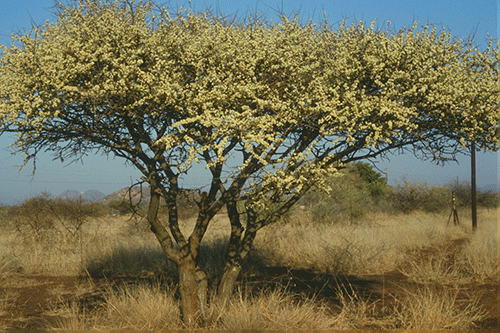The abundance of invader plant species in the Omaheke region continues to threaten limited grazing in the area.
Many villages in the region are surrounded by different species of invader bush, most of which sprout at the onset of the rainy season.
Farmers say this invader bush and plants, such as the ever-prevalent Black Thorn Acacia, have made it difficult for pastures to recover after the annual dry period as they compete with the grass.
The Black Thorn Acacia is one of the most common invader bush species in southern Africa, and it is found in various regions of Namibia.
Also known as Hook Thorn in English or Swaarthaak, Blouhaak and Hakiesdoring in Afrikaans, the Black Thorn has an extensive root system that explores large volumes of soil, allowing survival in dry areas.
In Otjiherero, which is the dominant language spoken in the Omaheke region, it is called ‘Omusaona’.
The Black Thorn is one of the most common Acacias in Namibia only absent from the Namib and the Cuvelai, and it is less common in the northwest.
Due to its highly invasive nature, this shrub or tree has a very damaging impact on the carrying capacity of Namibian rangelands. Although this acacia species has a dominant appearance in the region, it is not the only form of invader and invasive bush in the area.
The Aminuis communal area, which is one of those worst affected areas during the drought, has a handful of these invader bush species, which has farmers worried.
Erwin Tjituka, a farmer in the area, told AgriToday that various villages in the constituency had formulated plans to uproot most of the invader bushes in the area at their costs. While some have started with such plans, many are yet to get going, mainly due to the high costs usually associated with such exercise.
“It is not an easy thing to do due to the fact that these plants are all over the Aminuis communal farming area. So, it is not a one-day job; it is work that needs to be carried out continuously for the problem to disappear,” said Tjituka.
Bush encroachment lowers livestock capacity, reduces biodiversity and limits the recharge of groundwater.
For an area that is heavily dependent on livestock for survival, farmers here are worried.
Menesia Hambira from Epukiro said she has, for years, tried to get rid of encroaching bush species in her cattle camp, but it has been a futile exercise, as such plants seem to appear at a much faster pace than the rate at which it is being uprooted.
“When you uproot in one area, these plants are already sprouting on the other side. It is quite a futile exercise, but we cannot fold our arms and sit still, as the survival of our livestock depends on us,” she said.
Weed is a common encroacher of otherwise fertile grazing pastures, as the same rain that wets the pastures also grows the weed, farmers said.
Bush encroachment remains a major agricultural problem in Namibia, covering about 45 million hectares of the country’s savannas, and reducing livestock productivity significantly.
The main reasons for this, according to several studies, are decades of overgrazing, the suppression of natural savannah fires and the prevention of natural migrations of wild animals through fences.
Other causes include the increase in carbon dioxide in the atmosphere and changes in rainfall patterns due to climate change, which promote the growth of woody species over grass.
Namibia, where more than 70% of the population is directly or indirectly dependent on agriculture, has been suffering massively and increasingly for decades from bush encroachment in productive savannahs.
Bush encroachment, however, offers an opportunity for Namibia’s economic development. The bush biomass-processing sector in Namibia is developing dynamically.
The biomass produced by bush thinning can be processed in many ways, and it is already a source of income for farmers and companies.
Bush wood is a raw material for firewood, animal feed, charcoal and biochar, building materials or wood-plastic composites.


